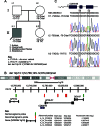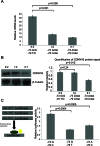Deficiency of the cyclin-dependent kinase inhibitor, CDKN1B, results in overgrowth and neurodevelopmental delay
- PMID: 23505216
- PMCID: PMC3708111
- DOI: 10.1002/humu.22314
Deficiency of the cyclin-dependent kinase inhibitor, CDKN1B, results in overgrowth and neurodevelopmental delay
Abstract
Germline mutations in the cyclin-dependent kinase inhibitor, CDKN1B, have been described in patients with multiple endocrine neoplasia (MEN), a cancer predisposition syndrome with adult onset neoplasia and no additional phenotypes. Here, we describe the first human case of CDKN1B deficiency, which recapitulates features of the murine CDKN1B knockout mouse model, including gigantism and neurodevelopmental defects. Decreased mRNA and protein expression of CDKN1B were confirmed in the proband's peripheral blood, which is not seen in MEN syndrome patients. We ascribed the decreased protein level to a maternally derived deletion on chromosome 12p13 encompassing the CDKN1B locus (which reduced mRNA expression) and a de novo allelic variant (c.-73G>A) in the CDKN1B promoter (which reduced protein translation). We propose a recessive model where decreased dosage of CDKN1B during development in humans results in a neuronal phenotype akin to that described in mice, placing CDKN1B as a candidate gene involved in developmental delay.
© 2013 Wiley Periodicals, Inc.
Figures


Similar articles
-
Functional characterization of a rare germline mutation in the gene encoding the cyclin-dependent kinase inhibitor p27Kip1 (CDKN1B) in a Spanish patient with multiple endocrine neoplasia-like phenotype.Eur J Endocrinol. 2012 Mar;166(3):551-60. doi: 10.1530/EJE-11-0929. Epub 2011 Nov 30. Eur J Endocrinol. 2012. PMID: 22129891
-
A heterozygous frameshift mutation in exon 1 of CDKN1B gene in a patient affected by MEN4 syndrome.Eur J Endocrinol. 2014 Aug;171(2):K7-K17. doi: 10.1530/EJE-14-0080. Epub 2014 May 12. Eur J Endocrinol. 2014. PMID: 24819502
-
Prognostic role of the CDNK1B V109G polymorphism in multiple endocrine neoplasia type 1.J Cell Mol Med. 2015 Jul;19(7):1735-41. doi: 10.1111/jcmm.12552. Epub 2015 Mar 30. J Cell Mol Med. 2015. PMID: 25824098 Free PMC article.
-
Multiple endocrine neoplasia syndromes associated with mutation of p27.J Endocrinol Invest. 2013 Oct;36(9):781-7. doi: 10.3275/9021. Epub 2013 Jun 26. J Endocrinol Invest. 2013. PMID: 23800691 Review.
-
MEN4 and CDKN1B mutations: the latest of the MEN syndromes.Endocr Relat Cancer. 2017 Oct;24(10):T195-T208. doi: 10.1530/ERC-17-0243. Epub 2017 Aug 19. Endocr Relat Cancer. 2017. PMID: 28824003 Free PMC article. Review.
Cited by
-
An autoregulatory cell cycle timer integrates growth and specification in chick wing digit development.Elife. 2019 Sep 23;8:e47625. doi: 10.7554/eLife.47625. Elife. 2019. PMID: 31545166 Free PMC article.
-
Enzyme Inhibitors from Gorgonians and Soft Corals.Mar Drugs. 2023 Jan 31;21(2):104. doi: 10.3390/md21020104. Mar Drugs. 2023. PMID: 36827145 Free PMC article. Review.
-
UBE3A: The Role in Autism Spectrum Disorders (ASDs) and a Potential Candidate for Biomarker Studies and Designing Therapeutic Strategies.Diseases. 2023 Dec 27;12(1):7. doi: 10.3390/diseases12010007. Diseases. 2023. PMID: 38248358 Free PMC article. Review.
-
Genetic variants for head size share genes and pathways with cancer.Cell Rep Med. 2024 May 21;5(5):101529. doi: 10.1016/j.xcrm.2024.101529. Epub 2024 May 3. Cell Rep Med. 2024. PMID: 38703765 Free PMC article.
-
Development of DNA Insertion-specific Markers Based on the Intergenic Region of Oplegnathus punctatus Cdkn1/srsf3 for Sex Identification.Mar Biotechnol (NY). 2024 Aug;26(4):687-695. doi: 10.1007/s10126-024-10336-6. Epub 2024 Jun 14. Mar Biotechnol (NY). 2024. PMID: 38874827
References
-
- Chang Bl. A polymorphism in the CDKN1B gene is associated with increased risk of hereditary prostate cancer. Cancer Res. 2004;64(6):1997–1999. - PubMed
-
- Fero ML, Rivkin M, Tasch M, Porter P, Carow CE, Firpo E, Polyak K, Tsai L, Broudy V, Perlmutter RM, Kaushansky K, Roberts JM. A syndrome of multiorgan hyperplasia with features of gigantism, tumorigenesis, and female sterility in p27Kip1 deficient mice. Cell. 1996;85:733–744. - PubMed
-
- Goto T, Mitsuhashi T, Takahashi T. Altered patterns of neuron production in the p27 knockout mouse. Dev Neurosci. 2004;26(2–4):208–217. - PubMed
-
- Kiyokawa H, Kineman RD, Manova-Todorova KO, Soares VC, Hoffman ES, Ono M, Khanam D, Hayday AC, Frohman LA, Koff A. Enhanced growth of mice lacking the cyclin dependent kinase inhibitor function of p27Kip1. Cell. 1996;85:721–732. - PubMed
Publication types
MeSH terms
Substances
Grants and funding
LinkOut - more resources
Full Text Sources
Other Literature Sources
Medical
Miscellaneous

